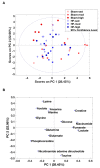The Effect of Exercise Training on Myocardial and Skeletal Muscle Metabolism by MR Spectroscopy in Rats with Heart Failure
- PMID: 30893827
- PMCID: PMC6468534
- DOI: 10.3390/metabo9030053
The Effect of Exercise Training on Myocardial and Skeletal Muscle Metabolism by MR Spectroscopy in Rats with Heart Failure
Abstract
The metabolism and performance of myocardial and skeletal muscle are impaired in heart failure (HF) patients. Exercise training improves the performance and benefits the quality of life in HF patients. The purpose of the present study was to determine the metabolic profiles in myocardial and skeletal muscle in HF and exercise training using MRS, and thus to identify targets for clinical MRS in vivo. After surgically establishing HF in rats, we randomized the rats to exercise training programs of different intensities. After the final training session, rats were sacrificed and tissues from the myocardial and skeletal muscle were extracted. Magnetic resonance spectra were acquired from these extracts, and principal component and metabolic enrichment analysis were used to assess the differences in metabolic profiles. The results indicated that HF affected myocardial metabolism by changing multiple metabolites, whereas it had a limited effect on skeletal muscle metabolism. Moreover, exercise training mainly altered the metabolite distribution in skeletal muscle, indicating regulation of metabolic pathways of taurine and hypotaurine metabolism and carnitine synthesis.
Keywords: MRS; cardiac metabolism; magnetic resonance spectroscopy; metabolomics.
Conflict of interest statement
The authors declare no conflict of interest.
Figures






References
Grants and funding
LinkOut - more resources
Full Text Sources
Research Materials
Miscellaneous

